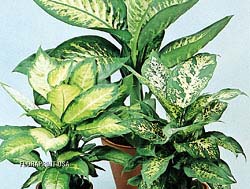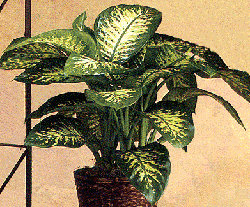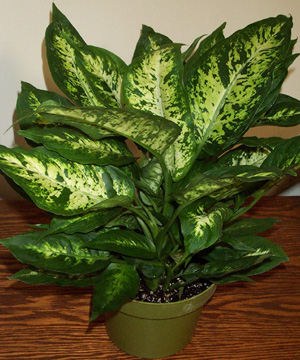|
Plants for your home
(By Mary Efanti)
Dieffenbachia
Description - Origin
 Oh
yes, the name does not ring a bell and it all sounds Greek to you. But take a look at the picture . . . you will definitely recognize the plant even if you did not know its
name. All the varieties of this plant come mainly from Brazil or
Colombia, Costa Rica, Puerto Rico and the West Indies. It is said that the plant came to Europe from Brazil around 1830 with a gardener called Dieffenbach
(and named after him). Oh
yes, the name does not ring a bell and it all sounds Greek to you. But take a look at the picture . . . you will definitely recognize the plant even if you did not know its
name. All the varieties of this plant come mainly from Brazil or
Colombia, Costa Rica, Puerto Rico and the West Indies. It is said that the plant came to Europe from Brazil around 1830 with a gardener called Dieffenbach
(and named after him).
Originally it was a greenhouse plant but the recent scientific advances helped evolve new varieties that are easy to keep
indoors. This plant is very popular worldwide mainly due to its easy care and for its impressive
foliage. Its stems look like canes that can reach a height of 1 m or
more. Its large leaves are oval in shape with sharp edges or in other varieties long and
narrow. The base of each leaf is wrapped around the stem. The differences between varieties
are, apart from the shape of leaves, in the second color of the
leaves, in tones that vary from pale white to vivid yellow.
We must stress that all parts of the plant contain an enzyme that is extremely poisonous for little children or
pets. If any part of the plant is consumed, this enzyme causes swelling of the pharynx and the tongue to a point where it can obstruct airways and lead to
death. Place these plants at spots where kids and pets cannot
reach, e.g. on top of a table or shelf or even better on a window-sill. If there is no way to keep the plant away from your
"hungry" roommates, avoid getting a dieffenbachia or if you already have one think about handing it over to a
friend.
Care
 Dieffenbachias need plenty of filtered
light. The average indoor temperatures are suitable for the plant but do not expose it to extreme heat or extreme
cold. Most houses are low in humidity, especially during the winter
months, so make sure to provide the necessary humidity to your
plant. Moreover, the abrupt temperature fluctuations stress the plant and fade the color of its
leaves. To avoid this, do not place the pot near doors, radiators or
heat-producing appliances such as the TV. Dieffenbachias need plenty of filtered
light. The average indoor temperatures are suitable for the plant but do not expose it to extreme heat or extreme
cold. Most houses are low in humidity, especially during the winter
months, so make sure to provide the necessary humidity to your
plant. Moreover, the abrupt temperature fluctuations stress the plant and fade the color of its
leaves. To avoid this, do not place the pot near doors, radiators or
heat-producing appliances such as the TV.
The plant is not very demanding in terms of soil but it should drain
well. Water only when the soil feels dry to the touch and use plenty of water each
time. Remove any excess water from the dish of the pot because, as most indoor
plants, the root system is very sensitive and rots easily.
Use liquid fertilizer twice a
year, in early spring and autumn. That should be enough but if you decide your plant needs some additional
help, check the instructions on the label and use half the dosage.
The wide leaves of the dieffenbachias tend to hold dust and this might obstruct their
breathing. Clean the leaves often, removing the dust with a wet sponge or cloth and mist them as often as
possible. Take care as its leaves are very tender and stems break
easily. For this reason you should avoid placing the pot in high traffic areas where people touch the plant while passing
by.
 In younger plants, most leaves come out of a single stem. As the plant grows and
matures, new stems appear at the sides and the plant gets bushier. The average height of dieffenbachias is less than 1m but with proper care and
time, it may get much higher than that. The development rate of the plant depends on the
conditions, if they are suitable the plant develops at impressively high speed while on the contrary it is static if
e.g. the plant does not get enough light. In younger plants, most leaves come out of a single stem. As the plant grows and
matures, new stems appear at the sides and the plant gets bushier. The average height of dieffenbachias is less than 1m but with proper care and
time, it may get much higher than that. The development rate of the plant depends on the
conditions, if they are suitable the plant develops at impressively high speed while on the contrary it is static if
e.g. the plant does not get enough light.
Your plant will grow impressively from spring till autumn if it gets enough light while during winter
months, when growth is always slower, you could move the plant closer to the window so that it gets more
light. A few hours of winter direct sunlight will not harm the
plant. Direct sunlight though is prohibited during the warmer
months.
As plants grow, the lower leaves drop and the beautiful
cane-like stems become visible. If the stems grow too tall for your
taste, prune them as hard as you wish and expect to see new stems coming out right below the point where you cut the old
growth.
Generally speaking, the plants sold in nurseries, need a stake as their foliage is very bushy while their stems are weak and cannot hold the
weight. A good way to strengthen the stems is to either prune back the stems or remove new growth from the center of the pot so that the plant channels its energy to the existing
stems. If you prune, keep in mind that the more leaves you remove, the less water your plant will need and be more cautious when
watering.
When you decide to buy a
dieffenbachia, check the plant thoroughly. It must have strong clean leaves coming out of sturdy strong
stems. The smaller in size (and younger) plants usually sold will most probably have only one stem while the more mature plants should have additional stems at the
sides.
When you prune do not discard the cut stems because the plant can be propagated from
cuttings. Place the cuttings directly in soil or into water until they develop roots and then plant them in a
pot. This method is quite successful, especially if done in spring or early summer before the temperatures get very
high.
As a rule, indoor plants are rarely attacked by insects or
disease. The rule applies to dieffenbachias as well. The main problems arise from too much or too little watering and because of some insects like aphids who could easily fly into your living room from your garden or
balcony. Cleaning the leaves often, especially the underside of
leaves, can effectively reduce the risk of such problems.
If the leaves turn yellow at the edges it is possible that you have over
fertilized. If however the whole leaf turns yellow and wilts or if the new leaves get smaller and smaller in
size, either the soil has become too poor or you over water. Low temperatures may also make leaves wilt but the plant will soon recover if the cold does not last for
long.
If you need to repot and your plant can
wait, do that in early spring. If your plant is young it would be advisable to repot each year in
spring, using a pot that is 1 or 2 sizes bigger. As the plant matures you can repot less
often, e.g. year after year or if due to size you cannot repot, remove as much soil as possible and replace it with new fresh
soil.
Give your dieffenbachia a little care and its impressive foliage will fill your home for a long
time.
Mary Efanti
[email protected]
|
